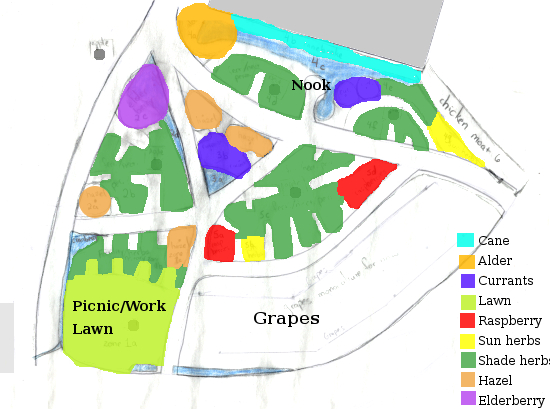
Choosing Plant Groupings for the Forest Garden

Based on the wetland and eventual canopy locations, I filled in plant
groupings on the map above. This was a pretty complicated step,
which I'll go into in far more detail than you'll care for.
First, I listed all of the plants I was interested in growing,
focussing mainly on plants which will increase fertility of the soil
but throwing in some nectary and edible plants as well. Then I
narrowed the plant list down to those which I can get my hands on for
free (primarily on my own property), or which I'm willing to spend
money on.
Next, I grouped the plants of interest into categories based on
disturbance intensity, sun/shade, and moisture level. The
categories are as follows:
- Canebrake --- wild
cane and mint growing
along barn with some kind of barrier so it won't invade the rest of the
garden. Regular disturbance as I harvest cane poles for building
and mint for nibbling.
- Fertility wetland --- alder shrubs (if I can find them), with horsetail and watercress in standing water. These are all primarily being grown to be cut for mulch and to feed nearby trees.
- Edible wetland ---
elderberry, with
cranberries between them. This habitat is primary for berries,
with nectaries for the beneficials, so it won't be disturbed much.
- Sun-loving herbs
--- Fertility plants (yarrow, chamomile, and comfrey) which I will
regularly harvest for mulch with the addition of fennel as a nectary.
- Fertility shade shrubs --- Hazel, with comfrey, dandelion, violet, and groundnut. Regular disturbance as I harvest for mulch.
- Fertility shade
herbs --- the category above, but without the hazel. I'm not sure
whether I trust shrubs not to compete with my trees, so I plan to stick
to herbs close to their trunks.
- Edible/nectary
shade shrubs --- Currants
with bee balm. Not much disturbance.
- Sunnier shrubs --- raspberries/blackberries with bee balm and chives. Moderate disturbance as I maintain cane fruits.
- Lawn --- just what
it sounds like. For our picnic/work area.
If you're still reading, here
was my reasoning behind choosing individual species. First, the
uses which are important to me.
- Building the soil ---
these fertility plants will be used for mulch, chicken feed, etc.
- Nitrogen fixers are in high demand since only a few species can take atmospheric nitrogen and turn it into a form other plants and animals can use
- Dynamic accumulators are good at reaching down into the soil to suck up trace minerals.
- Coppice species are shrubs or trees which can be cut back
repeatedly, creating woody biomass for mulch. (In a larger forest
garden, the woody biomass could also be used for firewood or mushroom
logs.)
- Attracting beneficial
insects --- nectaries
- Covering bare ground fast --- ground covers
- Edible --- I
didn't focus on this, but some of the species might make nice additions
to our dinner table.
The top species before I
narrowed it down (with ones I have nearby marked with an asterisk):
| Name |
Use |
Habitat |
| *Hazel |
edible,
fertility (coppice) |
sun |
| River
cane |
building
material |
wet,
sun |
| Ramps |
edible,
nectary |
shade |
| Cranberry |
edible,
ground cover |
wet,
sun |
| *Willow |
fertility
(coppice) |
wet,
sun |
| Alder |
fertility
(nitrogen fixer, coppice) |
wet,
sun |
| Currants |
edible,
nectary |
sun
to shade |
| *Violet |
fertility
(dynamic accumulator), ground cover |
sun
to shade |
| *Groundnut |
fertility
(nitrogen fixer), ground cover, nectary, edible |
sun |
| *Yarrow |
fertility
(dynamic accumulator), nectary, ground cover |
sun |
| *Chives |
fertility
(dynamic accumulator), edible, nectary, ground cover |
sun |
| *German
chamomile |
fertility
(dynamic accumulator), edible |
sun |
| *Horsetail |
fertility
(dynamic accumulator) |
wet,
partial shade |
| *Lemon
balm |
fertility
(dynamic accumulator), nectary, groundcover |
sun |
| *Spearmint |
fertility
(dynamic accumulator), edible, nectary, groundcover |
sun |
| *Watercress |
fertility
(dynamic accumulator), edible |
sun,
wet |
| *Comfrey |
fertility
(dynamic accumulator), nectary |
sun |
| *Dandelion |
fertility
(dynamic accumulator), nectary, edible |
sun |
| *Bee
balm |
nectary |
sun |
| *Elderberry |
edible,
nectary |
wet,
sun |
| *Fennel |
nectary |
sun |
| This post is part of our Planning The Forest Garden lunchtime series.
Read all of the entries: |
Want more in-depth information? Browse through our books.
Or explore more posts by date or by subject.
About us: Anna Hess and Mark Hamilton spent over a decade living self-sufficiently in the mountains of Virginia before moving north to start over from scratch in the foothills of Ohio. They've experimented with permaculture, no-till gardening, trailersteading, home-based microbusinesses and much more, writing about their adventures in both blogs and books.
Want to be notified when new comments are posted on this page? Click on the RSS button after you add a comment to subscribe to the comment feed, or simply check the box beside "email replies to me" while writing your comment.
